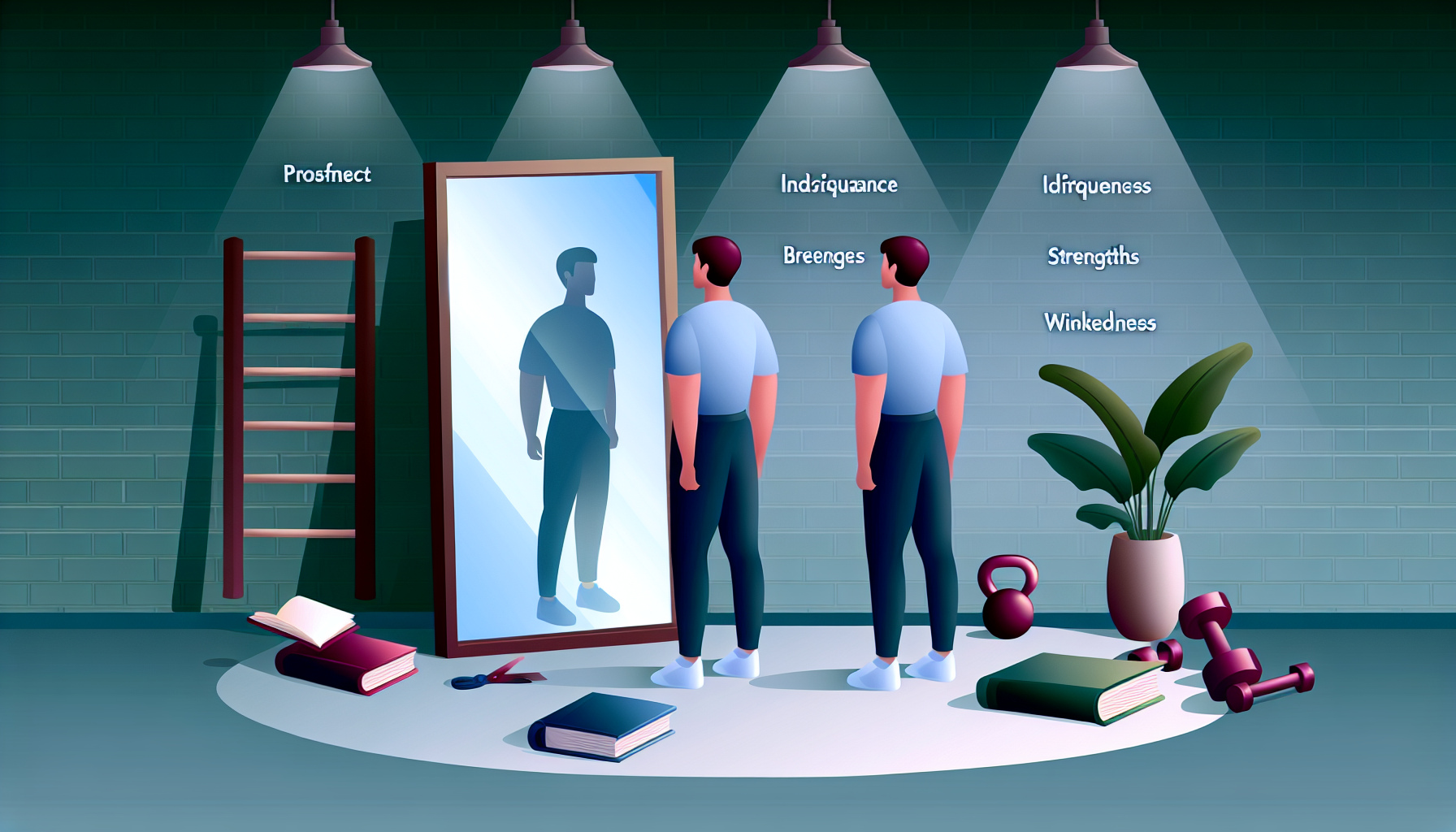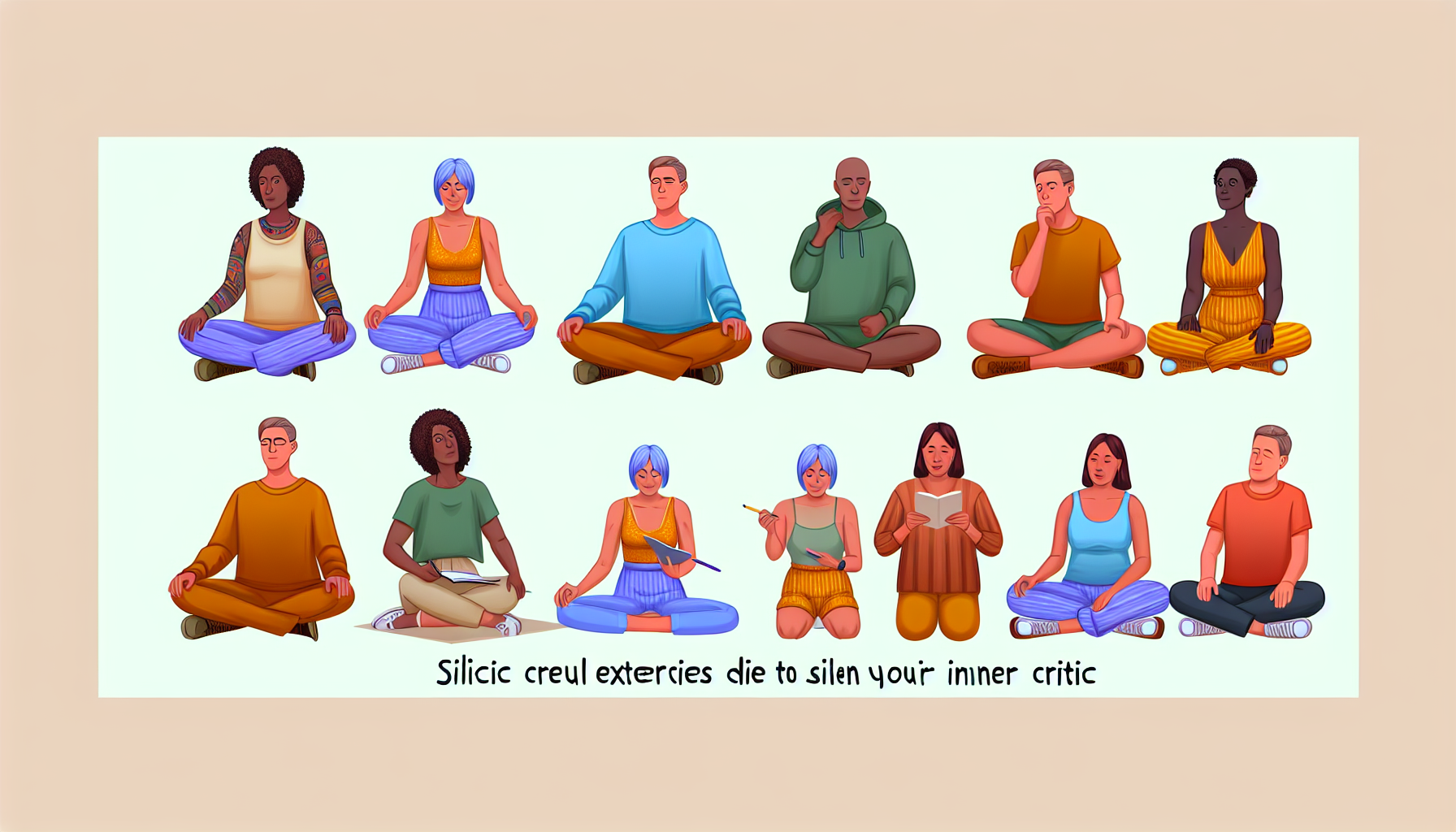Discover powerful strategies to conquer self-doubt and silence your inner critic. Transform your mindset and unlock your full potential today.

Self-doubt is a complex psychological phenomenon characterized by a lack of confidence in one’s abilities, decisions, and overall worth. Often rooted in early life experiences, negative feedback, and societal pressures, self-doubt can present itself in various aspects of an individual’s life. It may arise from personal comparisons, fear of failure, or a history of criticism, contributing significantly to an individual’s mental health. Such doubts frequently lead to feelings of inadequacy, impacting both personal and professional aspects of life.
The implication of self-doubt can be profound, affecting an individual’s self-esteem and ability to make decisions. Many people grapple with an internal dialogue that questions their competence, creating a cycle of uncertainty that can hinder growth. For instance, this inner critic often becomes rigorous during significant life events, such as job interviews, public speaking engagements, or important examinations. The nature of this self-criticism can vary from person to person, with some individuals feeling paralyzed by indecision while others may overcompensate through perfectionism, both of which are detrimental to personal development.
Furthermore, self-doubt can manifest in behaviors such as procrastination and avoidance, where individuals shy away from opportunities that could foster growth or success. This restrictive pattern of thinking not only stifles potential but also reinforces a negative self-image. Over time, chronic self-doubt can lead to anxiety, depression, and other mental health concerns, creating a detrimental feedback loop that can be challenging to escape. Addressing self-doubt is imperative for personal development, as it allows individuals to cultivate confidence and resilience, both crucial for achieving success in their endeavors.
The inner critic is an intrinsic voice that often emerges during formative years, shaped by various environmental influences such as parental expectations, societal norms, and personal experiences. This internal dialogue can serve a protective function, aiming to shield individuals from potential rejection or failure. However, the downside of the inner critic is profound; it can lead to heightened feelings of self-doubt, anxiety, and inadequacy. When individuals internalize these critical thoughts, they become trapped in a cycle of negative self-talk that hinders their ability to pursue goals and maintain positive self-regard.
Moreover, the inner critic often amplifies the importance of perfectionism, suggesting that anything less than flawless performance is unacceptable. Such unrealistic expectations may inhibit one’s willingness to take risks, stifling creativity and personal growth. In interactions with peers or authority figures, these negative beliefs can manifest as social avoidance or an inability to assert oneself, leading to decreased opportunities for advancement or fulfillment in both personal and professional contexts.
The influence of the inner critic extends beyond mere self-perception; it can significantly impact overall well-being. Individuals caught in the grip of self-scrutiny may experience not only diminished self-esteem but also adverse effects on mental health, contributing to stress, depression, and anxiety disorders. Cultivating awareness of this critical inner voice is the first step toward understanding its role in mental landscapes. By recognizing and challenging distorted thoughts, individuals can begin to disengage from harmful narratives, fostering a healthier and more supportive internal environment.
Ultimately, acknowledging the presence and impact of the inner critic is essential for anyone looking to build confidence and promote self-compassion. With deliberate effort, it is indeed possible to transform this often-harsh inner dialogue into a more constructive and gentle form of self-assessment, thereby promoting both personal development and emotional well-being.
The phenomenon of self-doubt operates within a cyclical framework, often leading individuals into a feedback loop that exacerbates negative thoughts and emotions. Self-doubt typically initiates a critical inner dialogue, which serves to amplify feelings of inadequacy. This criticism, often internalized from past experiences or societal expectations, can lead to heightened anxiety and decreased self-esteem. It is vital to understand how this cycle manifests in order to effectively address and manage these detrimental feelings.
Initially, an individual may encounter a situation or task that triggers self-doubt. This could stem from a fear of failure or an underlying belief that one is not competent enough to succeed. As self-doubt takes root, it cultivates an inner critic that engages in negative self-talk. This inner dialogue is marked by detrimental phrases that reinforce feelings of inferiority, and consistent exposure to this harsh critique can lead to emotional distress.
As self-doubt and the inner critic continue to interact, the individual may exhibit avoidance behaviors. This can include delaying important decisions or shying away from opportunities that may otherwise encourage personal growth. Such avoidance can further entrench feelings of failure and unworthiness, perpetuating the cycle. When faced with challenges, instead of adopting a proactive approach, individuals may retreat, thus fortifying their self-doubt and allowing the inner critic to persist unchallenged.
Moreover, this cycle is not just mentally cognizant; it can have physiological implications as well, potentially resulting in increased stress and anxiety levels. These outcomes serve to validate the pervasive self-doubt, creating a self-fulfilling prophecy. Consequently, understanding the cyclical nature of self-doubt is imperative, as breaking this pattern serves as the foundation for fostering self-compassion and improving mental health. By acknowledging and addressing these triggers, individuals can begin to disrupt the feedback loop that supports their inner critic and pave the way towards greater self-acceptance.
Understanding the roots of self-doubt is an essential step towards addressing it effectively. Triggers of self-doubt can manifest in various aspects of daily life, often stemming from specific situations, interactions, or even internal dialogues. By identifying these triggers, individuals can begin to formulate strategies that counteract the feelings of inadequacy and uncertainty that accompany self-doubt.
Reflective questions can serve as a valuable tool for uncovering these triggers. For instance, consider when you last experienced feelings of self-doubt. What were you doing at that moment? Were you in a high-pressure environment, or perhaps discussing your achievements? Identifying the context in which these feelings arise can provide insight into recurring patterns. Think about the people you interact with regularly; do certain individuals somehow amplify your insecurities? Recognizing these dynamics is crucial, as social interactions can greatly influence self-perception.
Scenarios to consider include situations involving public speaking, collaborative projects, or performance evaluations. Do you find yourself questioning your abilities more in these contexts? Reflect on your thought processes in moments of self-doubt. What specific thoughts arise? Often, individuals engage in negative self-talk, which serves to reinforce their insecurities. Jotting down these thoughts can be an enlightening exercise, revealing recurrent themes that contribute to your self-doubt.
Furthermore, it is helpful to explore your personal history. Have past experiences shaped your current self-perception? Understanding how previous failures or criticisms have impacted your confidence can shed light on your triggers. Ultimately, recognizing these triggers is not about self-criticism but about developing a deeper awareness of oneself. By pinpointing the sources of self-doubt, you can take the first step toward dismantling their influence on your life.

Self-awareness plays a pivotal role in building confidence and combating the pervasive influence of self-doubt. By understanding our thoughts, emotions, and behaviors, we can identify the roots of our insecurities and develop strategies to address them. One effective method for enhancing self-awareness is through mindfulness practices. Mindfulness involves being fully present in the moment and observing one’s thoughts and feelings without judgment. Engaging in activities such as meditation or deep breathing can help individuals cultivate this skill, allowing them to become more attuned to their internal dialogue.
Incorporating self-reflection into daily routines is another powerful strategy for boosting self-awareness. Keeping a journal can serve as a valuable tool for this purpose. By writing down experiences, thoughts, and feelings, individuals can track patterns related to self-doubt and identify triggers that activate their inner critic. Reflecting on past successes, no matter how small, can also highlight areas of personal strength, reinforcing self-belief and diminishing self-doubt. Regular self-reflection ensures that individuals can confront negative thought patterns and develop healthier coping mechanisms.
Additionally, seeking feedback from trusted peers or mentors can provide insights that enhance self-awareness. Constructive criticism offers an external perspective, often illuminating strengths that individuals may overlook due to their self-doubt. Engaging in honest discussions about personal and professional goals can enrich this process, as it helps to clarify aspirations and reinforce a sense of purpose. Moreover, this exchange can foster an environment of support that is crucial for nurturing confidence.
Integrating these practices into daily life not only promotes self-awareness but also empowers individuals to take proactive steps toward silencing their inner critic. As self-awareness deepens, so too does the ability to challenge negative beliefs, ultimately paving the way for increased confidence and resilience.
Positive affirmations serve as a powerful tool in combatting self-doubt and negative self-talk. These statements are designed to reinforce beliefs that promote self-worth and confidence. By consciously integrating positive affirmations into your daily routine, you can shift your mindset from a place of self-criticism to one of self-acceptance and motivation. The essence of affirmations lies in their potential to reshape thought patterns, allowing individuals to confront and reduce the effects of their inner critic.
Effective affirmations often focus on specific areas where individuals may struggle with negative beliefs. For instance, someone who doubts their capabilities at work might use affirmations such as “I am competent and capable of handling challenges” or “I succeed in my professional endeavors.” These statements not only counteract detrimental thoughts but also serve to reinforce an individual’s sense of agency and competence. Additionally, personalization is key. Tailoring affirmations to reflect personal values ensures they resonate on a deeper level, making them more impactful in fostering a positive mindset.
To create your own positive affirmations, start by identifying your negative self-talk patterns. Once you have pinpointed these areas, reframe them into constructive statements. For example, if you often think, “I am not good enough,” you could transform this into, “I am worthy and deserving of success.” Incorporate these affirmations into your daily life by repeating them regularly—whether in front of a mirror, during meditation, or while journaling. Over time, as you reinforce these positive beliefs, you may find that your inner critic becomes quieter, allowing your self-confidence to flourish.
Resilience is a vital aspect of personal development, particularly in the face of self-doubt. Building resilience enables individuals to withstand challenges and setbacks while maintaining a focus on their goals. To effectively combat self-doubt, one can adopt several actionable strategies that reinforce a resilient mindset.
One of the most effective strategies for developing resilience is embracing a growth mindset. This concept, popularized by psychologist Carol Dweck, emphasizes the belief that abilities and intelligence can be developed through dedication and hard work. By shifting the focus from a fixed mindset, which believes talents are inherent and unchangeable, to a growth mindset, individuals can view failures not as a reflection of their worth but as valuable learning experiences. This viewpoint encourages them to be more forgiving of themselves during challenging situations and to treat setbacks as opportunities for improvement.
In addition to cultivating a growth mindset, it is important to practice self-compassion. This involves treating oneself with the same kindness and understanding one would offer to a friend facing difficulties. Self-compassion helps quell the inner critic that often amplifies feelings of self-doubt. By acknowledging that imperfection is part of the human experience, individuals can foster a more compassionate dialogue with themselves, which can mitigate feelings of inadequacy.
Furthermore, resilience can be strengthened by setting realistic goals and developing problem-solving skills. By breaking larger tasks into smaller, manageable objectives, one can experience regular accomplishments. These achievements not only reinforce confidence but also provide tangible evidence against self-doubt. Moreover, learning to approach challenges systematically bolsters one’s capability to navigate obstacles successfully.
In conclusion, developing resilience against self-doubt is an ongoing process that involves adopting a growth mindset, practicing self-compassion, and enhancing problem-solving abilities. By implementing these strategies, individuals can create a robust foundation for personal development, ultimately silencing their inner critic and fostering a more positive self-image.
Self-compassion is a vital practice in the journey of overcoming self-doubt. It refers to being warm and understanding toward ourselves when we experience failures or feel inadequate, rather than resorting to critical self-talk. This approach not only alleviates the burden of negative self-perception but also nurtures resilience. Embracing self-compassion can significantly fortify one’s emotional well-being and diminish the harshness of the inner critic.
To develop self-compassion, one effective technique is to engage in regular self-care practices. Self-care can take many forms, including maintaining a balanced diet, ensuring adequate rest, and participating in activities that bring joy and relaxation, such as reading or engaging in hobbies. By nurturing both the body and mind, individuals cultivate a sanctuary that fosters kindness towards themselves. This holistic approach contributes to a greater sense of self-worth, making it easier to confront self-doubt head-on.
Another beneficial strategy for fostering self-compassion is reframing self-criticism. This involves recognizing negative thoughts and consciously choosing to replace them with more constructive and kind perspectives. For instance, instead of labeling oneself a failure after making a mistake, individuals can remind themselves that errors are part of the learning process. This shift in mindset reduces the grip of self-doubt and allows individuals to acknowledge their human imperfections without being overly punitive. By implementing such reframing techniques, individuals can cultivate a more compassionate internal dialogue, significantly counteracting their inner critic.
By prioritizing self-compassion through dedicated self-care and the practice of reframing criticism, individuals can create a positive internal environment. This will not only help silence the inner critic but also empower them on their journey towards personal growth and self-acceptance.
Goal-setting is a fundamental practice that can significantly enhance self-esteem and mitigate feelings of self-doubt. By establishing clear, attainable objectives, individuals can create a structured pathway towards personal enhancement and fulfillment. Realistic goals serve as benchmarks of progress, enabling one to measure achievements and recognize their competence. This fosters a sense of capability and encourages further action.
When setting goals, it is essential to ensure they are Specific, Measurable, Achievable, Relevant, and Time-bound (SMART). Specificity in goals helps in clearly identifying what one aims to achieve, while measurability allows for tracking progress along the way. Achievable goals avoid setting individuals up for failure, thereby reinforcing their self-worth as they attain them. Relevance ensures that the goals align with personal values and long-term aspirations, creating a deeper motivation to pursue them. Lastly, establishing a timeline for achievement encourages accountability and determination.
Moreover, breaking larger goals into smaller, manageable tasks can lead to incremental victories, which are crucial for boosting self-esteem. Each completed task represents a step toward the overarching objective and provides an opportunity for celebration. It is important to recognize and appreciate these small wins, as they contribute to a positive self-image and help in silencing the inner critic.
Building self-esteem through goal-setting also entails being flexible and forgiving with oneself. It is vital to understand that setbacks and challenges are part of any journey. Instead of allowing these experiences to breed self-doubt, individuals can learn from them and adjust their goals accordingly. This adaptive mindset fosters resilience and encourages ongoing personal growth. Ultimately, by setting realistic goals, individuals can lay a solid foundation for enhanced self-esteem and a strengthened sense of self-worth.
Overcoming self-doubt can often feel like an insurmountable challenge when faced alone. However, seeking support from a community can significantly ease the burden and foster personal growth. A supportive network can come in various forms, including friendships, family, professional associations, and mentoring relationships. These connections provide not only emotional encouragement but also practical insights to navigate self-doubting thoughts.
Building a support system begins with identifying individuals who resonate with your experiences and values. Engage with peers who share similar challenges, aspirations, or interests. This could involve joining groups focused on personal development, participating in workshops, or even online forums. When surrounded by like-minded individuals, it becomes easier to share fears and insecurities openly, thereby normalizing the experience of self-doubt.
Mentorship plays a crucial role in this supportive dynamic. A mentor can offer guidance based on their experiences, providing a roadmap through similar obstacles. They can help you recognize your strengths, countering self-critical narratives that may arise. The wisdom gained from their journeys serves not only as motivation but also as a validation of your potential. When seeking out a mentor, choose someone whose accomplishments and values align with your goals, as this connection will enhance the learning process.
Peer encouragement is equally valuable. Engaging in constructive discussions with peers can foster motivation and accountability. A simple reminder from a friend that you are capable and deserving can shift your perspective away from self-doubt. Additionally, participating in group activities can strengthen bonds and further reinforce a sense of community.
In conclusion, surrounding yourself with a supportive network is a significant step towards conquering self-doubt. By fostering connections, seeking mentorship, and engaging with peers, you gain access to a wealth of resources that can empower you to silence your inner critic and embrace your potential.

Silencing the inner critic requires intentional practice and various exercises that promote self-awareness and positive thinking. One effective method is journaling, where individuals can document their feelings, thoughts, and experiences. Journaling prompts such as “What am I proud of today?” or “What positive affirmations can I tell myself?” encourage reflection and help identify the source of self-doubt. This activity not only clarifies emotions but also enables individuals to challenge their negative beliefs by providing evidence of their accomplishments.
Visualization techniques also serve as powerful tools in combating an inner critic. By picturing oneself succeeding in various scenarios, one can create a mental rehearsal of success. For instance, imagine walking into a meeting prepared and confident, or completing a challenging task with ease. Such visualizations can foster a sense of capability and diminish the power of self-doubt. Creating a mental image where one is thriving encourages a positive mindset and bolsters self-esteem.
Moreover, cognitive-behavioral strategies can aid in reshaping negative thought patterns. Identifying and reframing irrational thoughts is paramount. For example, if an individual thinks, “I always fail,” this belief can be countered with “I have learned from my past experiences and can improve.” Practicing cognitive restructuring allows one to challenge these erroneous assumptions systematically and replace them with more balanced thoughts. Over time, this shift can significantly reduce the frequency and intensity of self-critical thinking.
Implementing these exercises consistently can be transformative. Engaging in these practices fosters resilience against the inner critic, creating a more supportive internal dialogue. Over time, individuals can develop a more compassionate relationship with themselves, leading to enhanced confidence and self-acceptance.
Overcoming self-doubt is not a one-time achievement but rather an ongoing journey that necessitates consistent personal development. As individuals navigate through various life experiences, their self-perception and confidence can fluctuate. This variability underscores the importance of adopting a proactive approach to personal growth, allowing one to effectively silence their inner critic over time.
To embark on this journey, it is essential to cultivate self-awareness. Regular reflection on one’s thoughts, feelings, and behaviors can bring to light the triggers of self-doubt. Journaling is a potent tool in this regard, as it encourages the exploration of negative thoughts and facilitates the identification of patterns. Through such practices, individuals can better understand the nature of their self-criticism, thus enabling them to confront and counter these thoughts with constructive affirmations.
Additionally, setting realistic and achievable goals plays a crucial role in sustaining progress. When individuals establish small milestones on their journey, each accomplishment serves as a stepping stone, reinforcing confidence and diminishing feelings of inadequacy. It is also beneficial to revisit and adjust these goals over time, accommodating the inevitable shifts in one’s circumstances and aspirations. Flexibility in goal-setting helps to maintain motivation and adapt strategies that resonate with one’s evolving self.
Engaging with supportive communities can further bolster one’s commitment to personal development. Whether through workshops, online forums, or local meet-ups, surrounding oneself with like-minded individuals who share similar inclinations fosters a sense of belonging. Through sharing experiences and receiving constructive feedback, individuals can gain new perspectives on overcoming self-doubt.
In conclusion, the pursuit of personal development is a dynamic and ongoing process that requires dedication, self-reflection, and adaptability. By embracing these strategies, individuals can foster resilience and continue to conquer self-doubt effectively over time.
Overcoming self-doubt is not merely a personal challenge; it is a journey that plays a critical role in the broader context of mental health. Throughout this blog post, we have explored various strategies to combat the inner critic that often holds us back from reaching our true potential. Acknowledging and understanding the presence of self-doubt is the first step toward empowerment. By recognizing that it is a part of the human experience, we can start to dismantle its negative influence on our lives.
One effective method discussed is the practice of self-compassion. By treating ourselves with the same kindness we would offer a friend, we can foster a more supportive inner dialogue. This shift in mindset encourages resilience, allowing us to confront our fears and insecurities with a balanced perspective. Additionally, setting realistic goals and celebrating small achievements can significantly boost our confidence and diminish feelings of inadequacy. These incremental steps empower us to silence our inner critic, enabling us to move closer to our aspirations.
Another vital strategy is cultivating a positive environment by surrounding ourselves with individuals who uplift and inspire us. The influence of a supportive community cannot be overstated; it provides both encouragement and accountability as we strive to challenge self-doubt. Moreover, engaging in mindfulness practices allows us to develop a greater awareness of our thoughts and feelings, equipping us with the tools to manage anxiety effectively.
In closing, embracing your true potential involves actively confronting self-doubt and changing the narrative that often undermines our confidence. By adopting the strategies outlined in this blog post, you can create a pathway toward a healthier mental state, one that prioritizes growth and self-acceptance. Remember, the journey to silence your inner critic is ongoing, but every step taken is a significant move toward a more fulfilling life.
Looking to advertise, promote your brand, or explore partnership opportunities?
Reach out to us at
[email protected]









Chose where you want to study, and we will let you know with more updates.